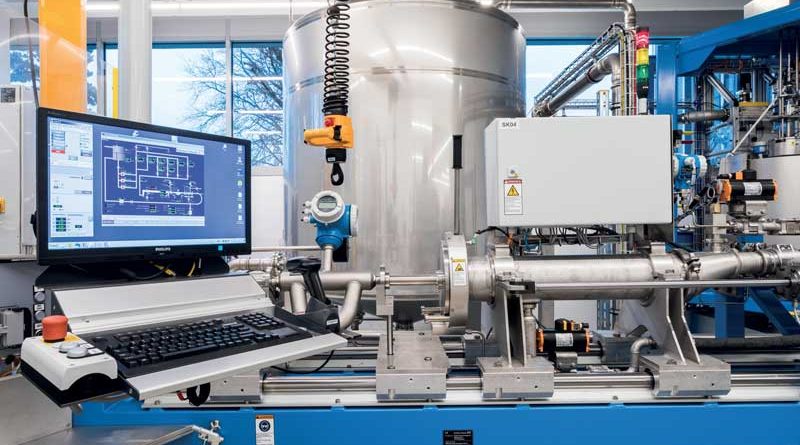Stationary flow calibration rig
With the static rig present in its Italian branch, Endress+Hauser broadens its flow meter calibration services: this machine caries out calibration of meters, even those used in critical processes with a minimum uncertainty value.
di Claudia Dagrada
The importance of verifying calibration regularly
Any industrial production, processing or treatment plant s equipped with flow meters. Flow is a physical parameter frequently used on process control, to carry out quantitative measurements of fluids. The accuracy of these measures must be regularly verified: the metrological characteristics of every instrument which influences product quality and the safety of the plant, environment and persons must be regularly submitted to calibration tests. Even the norms which apply to process domains, such as ISO9001, ISO14001, ISO50001, ISO 61511, GMP and IFS, demand such testing. Calibration consists in comparing the measurement of the meter being tested with a standard instrument: afterwards, the difference observed, that is, the deviation or error, is evaluated to check whether it is compatible with the use of the meter in the process.
Minimum uncertainty percentage thanks to the calibration on a rig
Calibration on the field allows to carry out this activity directly at the plant, with a minimum effect on production. By using detachments and junctions the meter is connected in series with the standard instrument, often enough without even having to disassemble it. This activity is however characterized by a rather high uncertainty level: for measurements carried out with portable ultrasound devices applied outside the pipes the best that may be obtained is 2%, while for measurements carried out with a mobile rig working with the Coriolis principle, in the best conditions a range from 0.21% to 0.25% may be achieved.
Calibration on a stationary rig represents a valid solution to carry out calibration of instruments used even in critical processes: it allows error correction to be carried out, bringing back the measurement accuracy property back to the original equipment values, something which may not be done on the field due to the excessive uncertainty given by mobile equipment.
The two calibration methods used
The stationary rig used at the Endress+Hauser Italia headquarters carries out mass and/or volume flow calibrations with an uncertainty value of 0.05%. This allows evaluation of the meter considering its absolute specifics, without any need for considerations as to the error which may be considered acceptable by the process.
The stationary rig carries out calibration using two methods. The Primary Gravimetric Method allows to carry out calibration by means of a water mass measured with a loading cell and a Flying Start and Stop deviation system; in this way a flow of 0.02 kg/s …10 kg/s (720 kg/h …36,000 kg/h) may be obtained, with an uncertainty of 0.05%.
By using the Secondary Master Method, calibration is carried out using a battery of metres which use the Coriolis principle, where the measurement is obtained by calculating the average of at least two standard instruments placed in series. The flow generated is 0.02 kg/s …27.8 kg/s (720 kg/h …100,080 Kg/h), the uncertainty value is equal to 0.08%.Calibration is carried out with water softened to zero French degrees. The rig is suitable for calibrating meters with a diameter of up to DN150 and a gauge of 1,180 mm. The stationary rig calibration service by Endress+Hauser broadens the range of flow calibration services carried out on the filed with mobile systems, and allows to comply with all flow meter calibration requirements.

